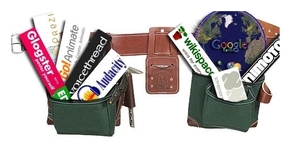Assignment 5: Toolbelt Theory
Each individual needs to assemble a set of learning tools to meet his or her unique needs.
Assignment 5 (Required)
Exploration and Product
With reference to 'Toolbelt Theory', as postulated by Ira Socol (see links below), assemble a toolkit of digital learning tools to support the learning needs of a learner of any age who faces significant learning challenges. This student may be hypothetical, or it may be someone you know. The toolkit may include options for written output, for accessing text, for facilitating access to other learning materials, for artistic expression, for some other specific need, or for any combination of needs. The learning toolkit may include commercial hardware and software, but it must also include free options that can be either downloaded and installed, or used online. [It is important to read the linked articles by Ira Socol, and to view the slide show at the bottom of this page, prior to putting together your toolkit.]
For some free toolkit options to consider, see Options for Access, Options for Representation, Options for Expression, and Options for Engagement on the site UDL Resource.
This assignment lends itself naturally to a presentation in slide-show format, perhaps with audio or captioned commentary; but it may be presented in any digital format you choose.
Exploration and Product
With reference to 'Toolbelt Theory', as postulated by Ira Socol (see links below), assemble a toolkit of digital learning tools to support the learning needs of a learner of any age who faces significant learning challenges. This student may be hypothetical, or it may be someone you know. The toolkit may include options for written output, for accessing text, for facilitating access to other learning materials, for artistic expression, for some other specific need, or for any combination of needs. The learning toolkit may include commercial hardware and software, but it must also include free options that can be either downloaded and installed, or used online. [It is important to read the linked articles by Ira Socol, and to view the slide show at the bottom of this page, prior to putting together your toolkit.]
For some free toolkit options to consider, see Options for Access, Options for Representation, Options for Expression, and Options for Engagement on the site UDL Resource.
This assignment lends itself naturally to a presentation in slide-show format, perhaps with audio or captioned commentary; but it may be presented in any digital format you choose.
|
"Toolbelt Theory" is based around the idea that as humans we are tool users, and that we choose tools most effectively when that choice begins with the Task at hand, and then considers the Environment in which that task must be performed, the Skill set of the individual (the tool chooser), and the Tools which are available (Thus the acronyn TEST)."
--Ira Socol |
|
The Toolbelt is intended to:
• Break the dependence cycle by facilitating independence • Develop lifespan technology skills • Limit limitations • Empower student decision making • Prepare students for life beyond school |
Header image by Natalie Lucier Toolbelt image by Gwyneth Anne Bronwynne Jones
